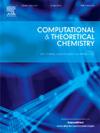m20和Mg19Zn团簇吸附CH4、CO、CO2、H2、H2O、N2、NH3、NO和NO2的密度泛函理论研究
IF 3
3区 化学
Q3 CHEMISTRY, PHYSICAL
引用次数: 0
摘要
本研究利用先进的计算方法研究了小分子(CH4, CO, CO2, H2, H2O, N2, NH3, NO和NO2)在原始m20和zn掺杂Mg19Zn团簇上的吸附机理和电子性质。采用ωB97XD泛函和Def2SVPP基集的密度泛函理论(DFT)计算准确捕捉色散相互作用和电子结构。使用人工蜂群算法对簇的几何形状进行全局优化,而自然键轨道(NBO)分析和分子原子量子理论(QTAIM)提供了对电荷转移机制和成键性质的见解。通过降低密度梯度(NCI-RDG)和总态密度(TDOS)计算进行非共价相互作用分析,以检验分子吸附效应和锌掺杂。吸附能趋势显示出相互作用强度的显著变化。极性和活性分子(如H2O和NO2)的吸附能最高,其中NO2的吸附能最强,分别为- 68.80 kcal·mol−1 (Mg20)和- 72.38 kcal·mol−1 (Mg19Zn)。非极性气体如CH4和H2表现出弱相互作用,吸附能在−0.85 ~−1.82 kcal·mol−1之间。由于锌对团簇电子性质的影响,Mg19Zn团簇始终表现出较高的吸附能,特别是对极性分子。QTAIM在键临界点(bcp)的电子性质分析表明,相互作用的类型和强度是系统依赖的,H2O、NH3、NO和NO2等分子的共价和离子相互作用更强。在Mg19Zn中,用Zn取代Mg增强了相互作用的离子性和极性。这些发现强调了簇组成在调节吸附行为中的作用,并为气敏和催化应用优化材料的设计提供了关键见解。本文章由计算机程序翻译,如有差异,请以英文原文为准。

A density functional theory investigation of the adsorption of CH4, CO, CO2, H2, H2O, N2, NH3, NO, and NO2 on Mg20 and Mg19Zn clusters
This study investigates the adsorption mechanisms and electronic properties of small molecules (CH4, CO, CO2, H2, H2O, N2, NH3, NO, and NO2) on pristine Mg20 and Zn-doped Mg19Zn clusters using advanced computational methods. Density Functional Theory (DFT) calculations with the ωB97XD functional and Def2SVPP basis set were employed to accurately capture dispersion interactions and electronic structure. Cluster geometries were globally optimized using the Artificial Bee Colony algorithm, while Natural Bond Orbital (NBO) analysis and Quantum Theory of Atoms in Molecules (QTAIM) provided insights into charge transfer mechanisms and bonding nature. Non-Covalent Interaction analysis via Reduced Density Gradient (NCI-RDG) and Total Density of States (TDOS) calculations were also performed to examine molecular adsorption effects and Zn doping. The adsorption energy trends revealed significant variation in interaction strengths. Polar and reactive molecules, such as H2O and NO2, exhibited the highest adsorption energies, with NO2 showing the strongest binding at −68.80 kcal·mol−1 (Mg20) and − 72.38 kcal·mol−1 (Mg19Zn). Nonpolar gases like CH4 and H2 demonstrated weak interactions, with adsorption energies ranging from −0.85 to −1.82 kcal·mol−1. The Mg19Zn cluster consistently showed higher adsorption energies, particularly for polar molecules, due to Zn's influence on the electronic properties of the cluster. Electronic property analysis at bond critical points (BCPs) using QTAIM indicated that the interaction type and strength were system-dependent, with stronger covalent and ionic interactions for molecules like H2O, NH3, NO, and NO2. The substitution of Mg with Zn in Mg19Zn enhanced the ionic and polar nature of interactions. These findings highlight the role of cluster composition in modulating adsorption behavior and provide key insights for the design of optimized materials for gas sensing and catalysis applications.
求助全文
通过发布文献求助,成功后即可免费获取论文全文。
去求助
来源期刊

Computational and Theoretical Chemistry
CHEMISTRY, PHYSICAL-
CiteScore
4.20
自引率
10.70%
发文量
331
审稿时长
31 days
期刊介绍:
Computational and Theoretical Chemistry publishes high quality, original reports of significance in computational and theoretical chemistry including those that deal with problems of structure, properties, energetics, weak interactions, reaction mechanisms, catalysis, and reaction rates involving atoms, molecules, clusters, surfaces, and bulk matter.
 求助内容:
求助内容: 应助结果提醒方式:
应助结果提醒方式:


